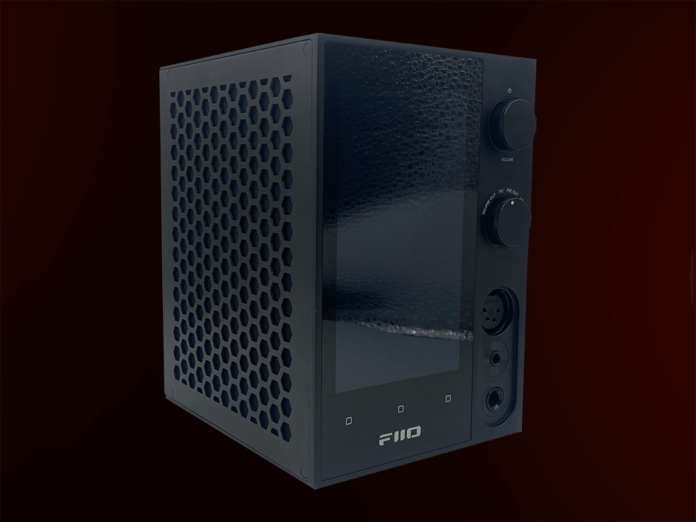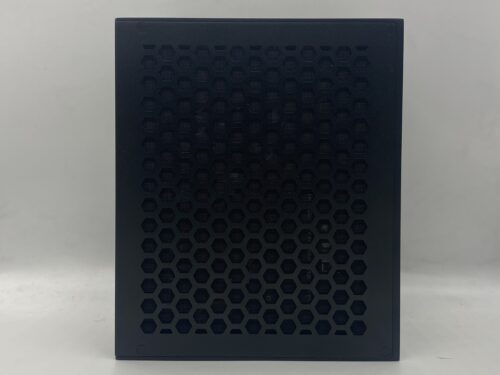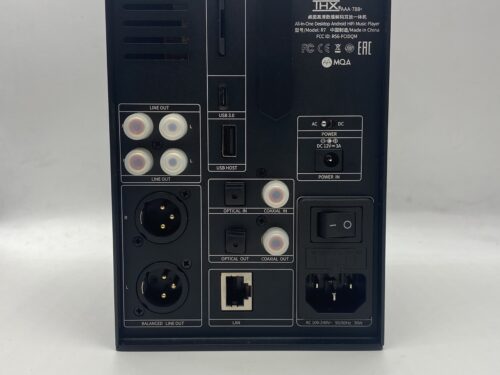There are a few all-in-one players out there, and most of them are pretty pricey. So, here comes Fiio trying to make these devices a bit more economical. The R7 is a player/streaming device that costs $699, which is a lot more reasonable price than most products like this. Does it still make for an ideal desktop system?
What You Get
- Power cord
- Angled base + flat base
- Double-sided tape for the bass
- Fuse + 6.35mm adapter
- USB cable
- Dustproof Plug
- User guide
- Warranty card
Build
The design of the R7 is kind of funny to me. It’s this rectangular black box with a screen, plugs, knobs, and vents. I find it a little odd, but it works for an all-in-one desktop player. This a sleek design that is uncomplicated, presenting everything it’s got right in front of you. You get a chassis that is up to the standard of rigidness and durability that many other Fiio products have, specifically their DAPs.
On the front, you have a 5-inch screen with two knobs next to it that control volume and output methods. For your headphone slots, you have the choice between quarter-inch, 4.4mm, and 4-pin XLR. There are tons of ins and outs on the back of the device too. You have two RCA line-outs, with an additional XLR line-out for a balanced connection. There are also slots for both USB-A and USB Type C, with a microSD slot resting on top. Other inputs and outputs include optical in and out, and coaxial in and out.
Design
Like many of Fiio’s players, the R7 sports ESS DAC chipsets. The R7 features a dual-DAC design capable of hi-res DSD up to 256. A ton of lossless formats are accepted like Apple lossless and FLAC up to 384kHz as its maximum. The R7 is also a full MQA decoder and even supported DTS up to 192kHz at 24bit. You also get dual THX AAA 788 amplifiers that supply ultra-high gain capability with multiple loudness options.
As for the operating system, you can expect a similar Android 10 OS that you’re used to seeing with most of Fiio’s DAP line. It’s powered by Snapdragon 660 and runs very smoothly.
Sound Impressions
There was never a bad pairing with the R7, especially when it came to soundstage and imaging dynamics. I found the best results with open-back headphones, which would obviously showcase how the R7 would perform here more precisely. With the 109 Pro, the R7 provides an incredible amount of depth and spaciousness. The R7 unravels more separation and air between sound elements. It almost appears like there’s minimal middle space. Rather, everything hovers around you holographically. So much of the imaging wraps around you effortlessly, as the R7 is able to heighten the headspace of your tracks significantly.
The Beyerdynamic DT 1990 needed to be put in its ultra-high gain mode for its 250 Ohm impedance. It offered me plenty of headroom, but still less than I thought the R7 was able to handle. My DT 1990’s performed exceptionally well with the R7, but I still had the feeling that it only just got there in terms of how much I was really getting out of this pairing. For the price, there have been other amps that run higher-impedance headphones a bit better, but what the R7 delivers is more than efficient.
Overall, the specific sound profile that the R7 likes to highlight consistently is within the bass. The low-end frequencies provided through the R7 felt a bit denser than what these headphones sound like in their natural state. It felt more concentrated and added a warmer timbre that expressed more subtlety than exaggeration. Everything felt concise and well-shaped within the mix. There wasn’t any instance of the R7 not sounding totally smooth and elegant, which is the case for most of their devices.
Summary
Although I find this an odd device, it operates as you’d expect it to. This is a neat all-in-one player/streamer that gives you all the best qualities that Fiio DAPs normally bring you. It fulfills Fiio’s standard for having a smooth interface that matches its level of sound quality. You also get a ton of input and output options for different source and headphone connections. If you’re in the market for a streamer like this and aren’t willing to spend more than a thousand dollars, then the R7 is a perfect choice.

The Fiio R7 is available at Audio46.
Compare the ranking of various headphones, earbuds and in-ear monitors using our tools.
Discuss this, and much more, over on our forum.
---MAJORHIFI may receive commissions from retail offers.


















